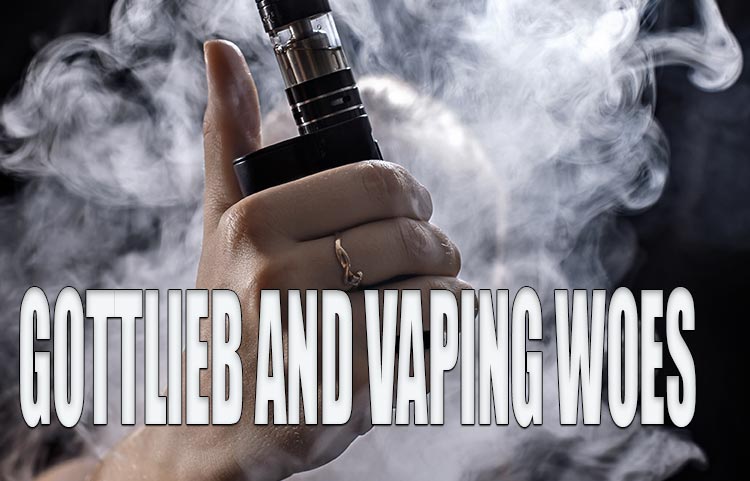Table of Contents [show]
Commissioner Scott Gottlieb of the U.S. Food & Drug Administration released a statement September 9th which is of particular concern to the vape industry.To read the entire statement, please click here.
The Statement from Gottlieb
Gottlieb said, to start, “Our comprehensive tobacco plan to combat the ill effects of smoking was founded on a central animating principle. That what primarily causes death and disease from tobacco use isn’t the nicotine in these products. It’s the act of lighting tobacco on fire to free that drug for inhalation. While it’s the addiction to nicotine that keeps people smoking, it’s primarily the combustion, which releases thousands of harmful constituents into the body at dangerous levels, that kills people.”
 This is a very reasonable statement, which many in the vaping industrywould agree with. Many people falsely assume that it is the nicotine in vape juice, or in cigarettes, that is dangerous. However, it is the combustible nature of the product that is the danger inherent in smoking. However, it is what Gottlieb says next that is scaring many in the industry:
This is a very reasonable statement, which many in the vaping industrywould agree with. Many people falsely assume that it is the nicotine in vape juice, or in cigarettes, that is dangerous. However, it is the combustible nature of the product that is the danger inherent in smoking. However, it is what Gottlieb says next that is scaring many in the industry:
“We need to make sure that we properly evaluate the net public health impact of products like e-cigs before they get marketing authorization from the FDA and that these products meet their regulatory responsibilities. Such products may still pose health risks, including possibly releasing some chemicals at higher levels than conventional cigarettes [emphasis added], and these potential risks require closer scrutiny.”
What? Which study (that hasn’t been proven wrong), says this? This is pseudo-science and is a dangerous precedent to set. The FDA is actually buying into the propaganda and denying the scientific facts,at the detriment of all the good the vaping industry is doing. But some people may say, “wait, I remember a study that said…”. However, these studies have been faulted for bad methodology, where the scientists purposefully misused the hardware to produce fake results. The FDA recently committed to following science in order to make decisions about vaping and vaping regulations.But, if that is the truth, then why are they following these debunked studies? One might even think there is an ulterior motive for purposefully punishing small vape businesses.
Here is another excerpt from the statement:
“We’re announcing the largest ever coordinated initiative against violative sales in the history of the FDA. This is the largest single enforcement action in agency history. It’s aimed at retail and online sales of e-cigarettes to minors.
We sent more than 1,100 warning letters to stores for the illegal sale of e-cigarettes to minors. In addition, we issued another 131 civil money penalties to stores that continued to violate the restrictions on sales to minors.
But we must do more to stem what I see as an epidemic of use of e-cigs among teens, and deeply disturbing trends that show no sign of abating. So, we’re also going to re-visit the compliance policy that we announced last summer to extend the application compliance periods for certain deemed products, including and especially the e-cigarettes that were on the market as of Aug. 8, 2016. Under the current policy, the compliance date for filing applications for such products was extended to Aug. 8, 2022.
We exercised that discretion for ENDS products because, as part of the tobacco and nicotine regulatory framework that we developed, which includes pathways to transition smokers off combustible cigarettes, we wanted to allow time for FDA to establish and more clearly explain the series of appropriate regulatory gates ‒ and for companies to prepare quality applications for new products like e-cigarettes. That’s where the e-cigarettes and other non-combustible products come into play. We wanted to make sure ‒ before we began enforcement of the application requirements ‒ that there was a clear, viable pathway to seek FDA authorization to market alternative products for adult smokers who still sought access to nicotine.
But in view of the accelerating use among youth, we’re actively considering whether we will enforce the premarket review provision earlier, when it is apparent that these products are now subject to widespread youth use.
One factor we’re closely evaluating is the availability of characterizing flavors. We know that the flavors play an important role in driving the youth appeal. And in view of the trends underway, we may take steps to curtail the marketing and selling of flavored products. We’re now actively evaluating how we’d implement such a policy.”
Actually, as many of you know, teen vaping is on the decline. In other words, policy does not have to be changed. Changing policy could, in fact, seriously harm public health. The FDA needs to re-evaluate how they are handling the industry and decide whether or not they want to help or harm the progress of helping smokers quit.
According to the CDC, smoking rates have hit a record low in the United States. They are down from 15.5 percent, reported in 2016, to 14 percent in 2017. The director of the CDC, Robert Redfield, had this to say, “This new all-time low in cigarette smoking among U.S. adults is a tremendous public health accomplishment — and it demonstrates the importance of continued proven strategies to reduce smoking.”
Latest Reports Show Smoking Rates Down
This latest report was published in the CDC’s Nov. 9 Morbidity and Mortality Weekly Report,16 million people in America have a smoking related illness. Shalini Reddy, of the Winchester Center, had this to say about quitting, “The minute that you think that you are going to quit smoking, that’s when the benefits start. Within a few hours of not smoking one cigarette, patients can start repairing themselves.”
The irony of this release from the CDC, is that nowhere does it say that the popularity of vaping contributed to these lower rates of smoking. In fact, the CDC worries that vaping will be the new smoking. This completely discounts the proven harm reduction that vaping contributes to when people decide to make the switch. The CDC has even previously admitted that vaping is less harmful and has contributed to the decline in smoking rates. In fact, so has the FDA.Many also remember that Public Health England has definitively proven that vaping is 95% less harmful than smoking.
The CDC and FDA are making a huge mistake by over-regulating the vaping industry and not embracing this CLEARLY effective form of harm reduction. As many in the community know, the boom of vaping, and the decrease in smoking rates, is no coincidence. Though it may be a balancing act for them, these government agencies seriously need to weigh the pros and cons of what is most effective for the improvement of public health.
Recently, the FDA banned flavors in convenience stores and are considering doing even more. These regulations should worry all in the industry and the community. We must come together and advocate for ourselves — educating the public.




